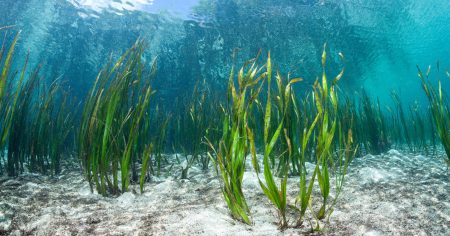Seaweed poses Threat to Coral Reef 29/05/2019 – Posted in: Daily News – Tags: coral, Gulf of Munnar
SEAWEED POSES THREAT TO CORAL REEF
For: Preliminary & Mains
Topic covers: Seaweed threat, coral reef, Negative impact, Gulf of Munnar
News Flash
The invasive Kappaphycus alvarezii seaweed, which smothers and kills coral reefs, has spread its wings to coral reef areas in Valai island in the Gulf of Mannar (GoM) and set to invade new coral colonies in the marine national park.
Highlights
- Research team observed that the destructive algae had invaded the reef areas of Valai Island.
- The algae was firmly attached to the coral colonies and started forming mat over them.
- It is most likely that Kappaphycus alvarezii would spread to new live coral colonies and cause significant coral mortality in Valai Island.
- Detached mats of the algae were also seen along the shores of the island and nearby Thalaiyari island.
- The destructive seaweed has invaded coral colonies in Valai island and posed a threat to other coral colonies.
Impact
Macrofaunal and fish density decreased when Kappaphycus cover increased.
Background
- After invading Shingle, Kurusadai and Mulli islands in Mandapam cluster of the GoM, the red algae invaded Valai island along Kilakarai coast following its cultivation in south Palk Bay.
- A 2005 Government Order had restricted cultivation of the exotic seaweed only to the seawaters north of the Palk Bay and South of Thoothukdi coast.
Research Project
The Reef Research Team (RRT) of Suganthi Devadason Marine Research Institute (SDMRI), Thoothukudi, undertook the four-year project, ‘Studies on the impact of the exotic seaweed, Kappaphycus alvarezii on corals, and the associated resources, and management measures in the Gulf of Mannar Marine National Park’, funded by the MoEFC.
Coral Reef
Coral reefs are some of the most diverse ecosystems in the world. Coral polyps, the animals primarily responsible for building reefs, can take many forms: large reef building colonies, graceful flowing fans, and even small, solitary organisms.
Coral reefs protect coastlines from storms and erosion, provide jobs for local communities, and offer opportunities for recreation. They are also are a source of food and new medicines. Over half a billion people depend on reefs for food, income, and protection. Fishing, diving, and snorkeling on and near reefs add hundreds of millions of dollars to local businesses.
Kappaphycus alvarezii
Kappaphycus alvarezii, the elkhorn sea moss, is a species of red algae. It is one of the most important commercial sources of carrageenans, a family of gel-forming, viscosifying polysaccharides. Farming methods affect the character of the carrageenan that can be extracted from the seaweed.
This alga grows to two meters long and is green or yellow in color. It is very fast-growing, known to double its biomass in 15 days.
Seaweed
Seaweed, or macroalgae, refers to several species of macroscopic, multicellular, marine algae.
Algae
Algae are a diverse group of aquatic organisms that have the ability to conduct photosynthesis. Certain algae are familiar to most people; for instance, seaweeds (such as kelp or phytoplankton), pond scum or the algal blooms in lakes.
Gulf of Munnar
- Gulf of Mannar is a repository of over 3,600 species of plants and animals and the first biosphere reserve in the South-East Asian region.
- It is one of the most biologically diverse coastal regions in the planet earth. It is also among the largest remaining feeding grounds for the globally endangered species namely dugong. Five different species of endangered marine turtles, innumerable fish, mollusks and crustaceans are also found here.
- The Gulf of Mannar region supports a variety of habitats within the main ecosystems of coastal lagoons, sea grass beds and coral reefs.
- Due to the high productivity of the area, it is an important fishing ground both for India and Sri Lanka.
- The marine environment and the aquatic species in the GOM are subjected to a great threat at present mainly due to use of harmful fishing methods/gear and extensive use of marine resources. Thus it is paramount important for both countries to safeguard the ecological status and sensitivity of this system.
- The Indian part of the Gulf of Mannar has been declared as Marine Biosphere reserve in 1989. It is also recognized under UNESCO MAB Programme (Man and Biosphere) for their value in conservation and management of natural resources through scientific research and monitoring to support sustainable development of resources.
Source: The Hindu
You can follow us on LinkedIn and for more updates related to UPSC IAS Preparation, Like our Facebook Page and subscribe our Diligent IAS Youtube Channel
Also Read Related Daily News


